Castlewellan
Castlewellan (from Irish Caisleán Uidhilín, meaning 'Hugelin's Castle') is a small town in County Down, in the north-east of Northern Ireland close to the Irish Sea. It is beside Castlewellan Lake and Slievenaslat mountain, 11 miles (18 km) southwest of Downpatrick. It lies between the Mourne Mountains and Slieve Croob. It had a population of 2,392 people in the 2001 Census.
Castlewellan
| |
|---|---|
 Castlewellan village, from the "Peace Maze" | |
 Location within County Down | |
| Population | 2,782 (2011 Census) |
| District | |
| County | |
| Country | Northern Ireland |
| Sovereign state | United Kingdom |
| Post town | CASTLEWELLAN |
| Postcode district | BT31 |
| Dialling code | 028 |
| UK Parliament | |
| NI Assembly | |
Castlewellan has a wide main street which runs through two main squares lined with chestnut trees. The town was designed by a French architect for the Annesley Family. The Annesley family did not always own the land as they bought it from The Maginess Family. (see Earl Annesley), then owners of what is now Castlewellan Christian Conference Centre and Forest Park, and is unique within Ireland due to its tree-lined squares both in the old town (upper square) and new town (lower square) as well as its very wide main street. The old market house in the upper square was built in 1764 and now houses the public library.[1]
Places of interest
- Drumena Cashel is a good example of a small stone built farmstead enclosure or cashel of the Early Christian period. It is situated 2 miles (3 km) south west of Castlewellan off the A25 road to Rathfriland.[2][3]
- Castlewellan Forest Park and Castlewellan Lake are situated to the northwest of the village. The Arboretum in the park was begun in 1740 and contains plants and trees from many different countries including Spain, Mexico and Wales;[4] the 'Castlewellan Gold' form of Leyland Cypress – originating from a single mutant tree in the arboretum and widely propagated from the 1970s – was selected by the park director, John Keown, being first named Cupressus macrocarpa Keownii, 1963.[5] The Peace Maze was constructed in the park between 2000 and 2001. Until 2007 it was the longest permanent hedge maze in the world.[6] In the very early hours of 7 April 2007 two youths died in a canoeing incident in the lake.[7]
- Castlewellan Castle, a Scottish baronial castle of 1856, overlooks the lake and the park. Nowadays the castle is used as a privately run Christian conference centre, and is not generally open to the public.
- Legannany Dolmen is 3 miles (4.8 km) north of Castlewellan, near the village of Leitrim, on the slopes of Slieve Croob.[8]
- Goward Dolmen is an impressive megalithic monument 2 miles (3.2 km) from Hilltown on the road to Castlewellan. It is known locally as Pat Kearney's Big Stone or Cloughmore Cromlech. The huge granite capstone has slipped from its original horizontal position.[9]
History
12 July 1849 saw the Dolly's Brae conflict. Up to 1400 armed Orangemen marched from Rathfriland to Tollymore Park near Castlewellan, County Down. On their homeward journey, shots were fired and police were unable to control the situation. None of the Orangemen were harmed, but it was estimated that about 80 Catholics were killed and homes burnt.[10]
According to the Sunday Times Insight Team, the entire village (the population then was given as 819) was bound over to keep the peace for a year in 1953 after disorder at an Orange walk.[11]
The Troubles
For more information see The Troubles in Castlewellan, which includes a list of incidents in Castlewellan during the Troubles resulting in two or more fatalities.
Castlewellan throughout the course of The Troubles, had a significant paramilitary presence in the Village, mostly through the presence of the Provisional Irish Republican Army (PIRA)
In January 2009 a 300 lb car bomb was abandoned outside Castlewellan. It had been destined for the British Army base at Ballykinler. Óglaigh na hÉireann claimed responsibility for the attack, saying that it had planned to drive the bomb through the gates of the barracks before detonating it.[12]
Schools
Transport
Castlewellan railway station was opened on 24 March 1906 by the Great Northern Railway of Ireland, but closed on 2 May 1955.[16]
Trains used to connect Newcastle and Belfast via Lisburn.
Music
The Celtic Fusion International Musical Arts Festival has been held annually in the town since 2002.[17]
The Soma Festival is an annual festival held in the town since 2013. Soma is a festival of live music, family, well-being, food and drink and is directed by singer Tíona McSherry.
Sport
- Castlewellan GAC is based in the village.
- Castlewellan Town FC are the local Football team [18]
- Castlewellan lake plays host to the Queen's Regatta, and formerly the Irish University Rowing Championships, annually in April.
- Kilmegan Amateur Boxing Club is situated in the outskirts of the town (taking its name from the towns parish name).
- Castlewellan Forest Park Played Host To The All British Open Field Archery Championships Put On And Arranged By Ballyvally Archery Club Banbridge The Weekend Of 28–29 May 2011
Demography
2001 Census
Castlewellan is classified as an intermediate settlement by the NI Statistics and Research Agency (NISRA)[19] (i.e. with population between 2,250 and 4,500 people). On Census day (29 April 2001) there were 2,392 people living in Castlewellan. Of these:
- 29.8% were aged under 16 and 13.8% were aged 60 and over
- 49.4% of the population were male and 50.6% were female
- 92.1% were from a Catholic background and 6.6% were from a Protestant background
- 4.8% of people aged 16–74 were unemployed.
People
- Greer Garson, actress
- Percy Jocelyn, Anglican Bishop
- Niamh McGrady, actress
- Séamus Ó Néill, Irish writer
- Joe Toner, soccer player.
See also
- Market Houses in Northern Ireland
References
- "Castlewellan.org".
- Drumena Cashel, Irish Antiquities, archived from the original on 14 March 2005
- Drumena Stone Fort, Megalithic Ireland
- "Forest Service". Archived from the original on 11 February 2006.
- Gerd Krüssmann, Manual of Cultivated Conifers, Portland: Timber Press, 1995, p. 101
- Peace Maze Archived 20 December 2005 at the Wayback Machine
- "Canoe tragedy victim 'was a hero'". BBC News. 7 April 2007.
- "Banbridge". Travel Now. Retrieved 11 December 2007.
- "Goward Dolmen in Clonduff parish". Ros Davies' Co. Down, Northern Ireland Genealogy Research Site. Retrieved 11 December 2007.
- "Parades and Marches - Chronology 2: Historical Dates and Events". Conflict Archive on the Internet (CAIN). Retrieved 28 January 2010.
- Template:Ulster (The Sunday Times Insight Team), 1972, p.96
- Rayment, Sean (25 April 2009). "Dissident republicans preparing to bomb UK". Telegraph (25 April 2009). London. Archived from the original on 29 April 2009. Retrieved 25 January 2010.
- "St Malachy's Primary School, Castlewellan".
- Clarke, Barry. "St Malachys High School - St Malachys High School Castlewellan".
- Boirche, Bunscoil Bheanna. "School Aims". Archived from the original on 6 May 2014.
- "Castlewellan station" (PDF). Railscot - Irish Railways. Retrieved 16 September 2007.
- "Celtic Fusion International Musical Arts Festival". Irish Music Magazine. Retrieved 5 May 2014.
- Castlewellan Town FC Archived 19 April 2010 at the Wayback Machine
- "NISRA - Northern Ireland Statistics and Research Agency (c) 2015".
External links
![]()
